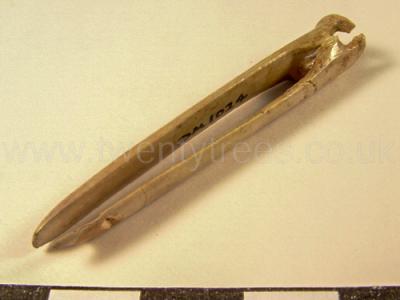Prehistoric Artefacts
Prehistoric Artefacts is in Prehistory.
Books, Prehistory, Prehistoric Artefacts, Antler Artefacts
Antler Picks
Marlborough Mound [Map]. Historic England 1005634.
This monument includes a motte castle situated on the summit of a ridge surrounded by a meander of the River Kennet and within the grounds of Marlborough College within a Grade II Registered Garden (2247). The motte survives as a circular mound of up to 85m in diameter and 18m high. Excavations in 1912 found layers of charcoal and antler picks which have long caused speculation as to whether this was a prehistoric earthwork which was re-used as a motte, although a survey in 2001 did not prove the castle to be anything other than medieval in origin. Further excavations in 1936 found the footings for a curtain wall and the buttress for a shell keep on the summit together with 12th to 13th century pottery. Speculation of this having once been part of a much larger castle with baileys was apparently fuelled by the discovery of a V-shaped profile ditch to the north of the motte in 2000 and it has long been believed that much of the bailey extended to the south although the extent of this is not known. In 2005 further excavations indicated the spiral path which winds its way up to the summit was in existence from 1654. Marlborough was part of a royal borough which was visited often by sovereigns, there is no documentary mention of a castle prior to 1138, but it is thought significant that William I imprisoned Bishop Aethelfric of Selsey in Marlborough and that Henry I held an Easter Court there in 1110. Also, several charters were signed in Marlborough which implies the castle did already exist. The first definitive documentary record was in 1139 when it was held by King Stephen from the Empress Matilda. There was further building work during the reign of Henry II which included the 'Great Tower' and continued from 1175 to 1179. King John had the castle repaired and a ring wall built around the motte in 1209-11. Henry III spent £2000 on works between 1227 and 1272 which included work on two chapels, the hall, the keep, two barbicans, a curtain wall, two bridges, gatehouse, and the Queen's apartments. From 1273-1369 it formed part of the Queen's possessions as her 'Dower House'. However, by 1403 it had deteriorated significantly and subsequently remained neglected. Allegedly the black marble font now in Preshute Church came from the castle chapel and was supposedly used to baptise King John and Edward the Black Prince. The winding path, a grotto (listed at Grade II) and a water tower on top of the motte were all landscape garden features from the 17th to 18th centuries. The grotto was originally part of a canal and cascade feature associated with the mound.
Antler Tool
2500BC to 2300BC. Bluestonehenge [Map] is a ring of pits at the termination of the Stonehenge Avenue [Map] at its southern end where it meets the Wiltshire River Avon. Stone chips were discovered. Originally thought to be of the Stonehenge Bluestones they were subsequently found not to be. Bluestonehenge [Map] is not a @@Henge. Radiocarbon dating of antler tools found at the site has provided only an approximate date of 2469 to 2286 BC for the dismantling of the stones.
Red Deer Antlers
Knap Hill [Map]. Historic England 1005704.
Summary: The site of Knap Hill, a Causewayed Enclosure. It encompasses an area of circa 2.4 hectares and consists of a single circuit of sub-triangular plan, conforming to the contours of the hill and possibly incomplete on the steepest, southern side. Exceptionally compared to other enclosures, the causeways seem to correspond precisely to gaps in the bank. It is unclear if the earthworks ever formed a complete enclosure. Excavations by the Cunningtons in 1908-9 first demonstrated the causewayed nature of the earthworks, as well as recovering pottery which they felt to be Neolithic in date. Further excavations in 1961 confirmed the Cunningtons' observations. Romano British pottery and an extended inhumation probably relates to the adjacent, later earthwork enclosure. The site and its archaeological history were re-investigated as part of the RCHME project focusing on enclosure and industry in the Neolithic period in 1995. Knap Hill was also subsequently included in a research programme into the dating of the early Causewayed Enclosures of southern Britain and of Ireland. The results suggested that Knap Hill was probably constructed in the 35th century cal BC, (that is to say between 3500-4001cal BC) probably more than a century later than Windmill Hill and the West Kennet long barrow [Map]. It is unclear, however, for how long activity continued. On the basis that the ditch was left to infill naturally, that there is no sign of recutting, and because there is a scarcity of sherds and bones, a short duration, probably of well under a century and perhaps only a generation or two, is possible.
More information: (SU 12106368) Neolithic Camp (NR) Knap Hill (NAT).
A causewayed camp on Knap Hill (see plan), excavated by BH and ME Cunnington in 1908-9 and G Connah in 1961. The excavations revealed Windmill Hill sherds in the silting of the ditches, Beaker sherds on the surface of the ditches and Romano-British sherds, probably associated with the plateau enclosure (see SU 16 SW 13). Other finds nearly all from within a few feet of the bottom of the ditch include fragments of red deer antlers, a human jawbone, flint flakes and a few sarsen chips. The finds are now in [Map]. Connah concludes from his excavations that the causewayed ditches undoubtedly belong to the Windmill Hill culture and that the scarcity of the pottery and occupation material may suggest that the camp was of a defensive character and abandoned at an early stage - perhaps before completion.
Radiocarbon dating of antler fragments from the primary rubble of the ditch - 4710+- 115 BP or 2760BC. Charcoal from the upper silting of the ditch - 3790+- 130BP or 1840BC.
SU 12106365 Knap Hill causewayed camp occupies a hill top position overlooking the Pewsey Vale to the S. The causewayed bank can be traced only on the N and W sides, but accepting the natural gradient of the hill for the eastern and southern extent, then the area enclosed would have been approximately 1.7 hectares. There is a bowl barrow (see SU 16 SW 23) and some flint digging disturbance within the camp, and in the E the perimeter of the IA/RB "plateau" enclosure obscures the terminal on the causewayed bank. Resurveyed in conjunction with RCHM manuscript plan at 1:2500.
The Neolithic causwayed enclosure and associated features described by the previous authorities have been mapped at 1:10,000 scale from aerial photographs and the 1:1000 plan produced as part of the industry and Enclosure in the Neolithic Project (Event UID 923509).
Surveyed by the RCHME as part of the above project.
Knap Hill encloses an area of 2.4 hectares and consists of a single circuit of sub-triangular plan, conforming to the contours of the hill and possibly incomplete on the steepest, southern side. Exceptionally to other enclosures, the causeways seem to correspond precisely to gaps in the bank.
Two radiocarbon dates were obtained by Connah following his 1961 excavations (Table 3.3: BM-205, -208; Connah 1969). They bracket the infilling of the ditch, the sample for BM-205 coming from near the base and that for BM-208 from the topmost fill. BM-205 was measured on an antler implement which had arguably been used to dig the ditch and would have been contemporary with that event. BM-208 was measured on an unidentified bulk charcoal sample which may have included material of diverse ages, and can hence provide only a terminus post quem for its context.
Knap Hill was included in a research programme into the dating of the early Causewayed Enclosures of southern Britain and of Ireland, using chronological estimates produced by Bayesian statistical analysis of radiocarbon dates. In addition to attempting to establish a construction date and duration for the monument, the proximity of the site to Windmill Hill and to a concentration of long barrows posed the question of its chronological relation to them. Six further radiocarbon measurements were therefore obtained. A model which incorporates this interpretation of the archaeological sequence with the radiocarbon dates was constructed. The model suggested that Knap Hill was probably constructed in the 35th century cal BC, probably rather more than a century later than both Windmill Hill Causewayed Enclosure [Map] and the West Kennet long barrow [Map]. It is unclear, however, for how long activity continued at this enclosure. On the basis that the ditch was left to infill naturally and there is no sign of recutting, and because there is a scarcity of sherds and bones, a short duration, probably of well under a century and perhaps only a generation or two, is plausible.
3000BC. Stonehenge Lesser Cursus is a Cursus around 400m long an 60m wide around 750 north-west of the Stonehenge Greater Cursus oriented west-southwest and east-northeast. It is now only visible as a cropmark. The Stonehenge Environs Project discovered Red Deer Antlers picks that dated the monument to 3000BC.
Books, Prehistory, Prehistoric Artefacts, Bone Pin
Section I Tumuli 1843. Saturday the 9th of September 1843 a remarkable barrow at Cross Lowe [Map], near Parwich [Map], was opened. It had every appearance of being a small tumulus about three feet in height; but was found to have been constructed above a depression in the rock, about two feet deep, thus increasing the height of the artificial structure to five feet. It was thought that the most effectual way of opening this barrow was to begin a cutting on both the north and south sides, and thus to meet in the middle; this was done with the following interesting results: on the north side a secondary deposit was founds about eighteen inches below the surface of the mound; it was the skeleton of a young person, and was accompanied by a small urn, much ornamented, and a bone pin. On the south side the floor was found to decline rapidly towards the centre, on approaching which a very rude cist was discovered, formed of stones set edgeways upon the solid rock, which supplied the bottom of the cist, on which lay a large and strong human skeleton, with the head towards the south-east; about a foot from the head was placed a coarse urn, sparingly ornamented. Besides these the cist contained a large quantity of rats' bones, one horse's tooth, the fragment of a celt, and a small piece of chipped flint; and at the feet of the skeleton lay a large heap of calcined human bones, which on examination proved to be the remains of two children; near them a curiously-shaped and neatly-ornamented urn was deposited. On removing a large stone, which formed that side of the cist approximating to the centre of the barrow, another skeleton was uncovered, which was that of a young person, accompanied by a small urn, or incense cup, which was placed at the head. The occurrence of this interment on the exterior of the cist caused a careful examination of the surrounding parts in the immediate neighbourhood of the principal interment, which led to the discovery of four more human skeletons, upon the same level, and to all appearance deposited there at the same time as the body within the cist. Near the surface of the tumulus another skeleton was disinterred, which was accidentally discovered by part of the skull falling down, owing to the ground being undercut, for the purpose of following up the traces of some of the other skeletons. It was not accompanied by relics of any description.
Books, Prehistory, Prehistoric Artefacts, Chalk Cups
Windmill Hill Causewayed Enclosure [Map]. Historic England 1008446.
The monument includes a Causewayed Enclosure, a small mortuary enclosure, part of an early prehistoric field system and a group of eight Bronze Age round barrows forming the core of a wider round barrow cemetery, all situated on Windmill Hill, a prominent but low hill north-west of Avebury. Until recently, the Causewayed Enclosure and broadly contemporary mortuary enclosure were thought to be the earliest evidence for human occupation of the hilltop. Prior to this date, however, it would appear that the hill was under cultivation. On the eastern side of Windmill Hill are a series of slight earthworks which form the outlines of field boundaries and enclosures. Recent survey work has suggested that this field system runs beneath the enclosure and is therefore of earlier date. The causewayed enclosure has a small circular area surrounded by three roughly concentric rings comprising banks and ditches, centred just north and downslope of the summit of Windmill Hill. The ditches are interrupted at regular intervals by causeways, created as a result of the gang construction method used to form the ditches and banks. The outer limits of the enclosure form an oval ring aligned roughly south-west to north-east. The overall dimensions of the enclosure are 400m by 300m at the widest points. Numerous excavations of the causewayed enclosure, originally by Keiller, then by Smith in the 1960s, and more recently by Whittle, have contributed much to our understanding of the site. Finds have included Neolithic flint artefacts such as arrowheads, axe-heads, a sickle blade and scrapers. Ceremonial chalk cups, animal bones and skulls have also been found.
A type of Neolithic pottery found on sites across Wessex was first identified here and has taken the name of the site. The enclosure was in use from about 3000BC to around 2500BC. Broadly contemporary with the causewayed enclosure, and situated to the east and located immediately outside a causeway leading into the outer ring of earthworks, is a mortuary enclosure. This was used for the exposure of human corpses prior to their formal burial in mounds or chambered tombs such as nearby West Kennet [Map]. Although not visible at ground level, it survives as a rectangular enclosure 33.5m long by 22m wide defined by a buried ditch 0.3m wide.
Books, Prehistory, Prehistoric Artefacts, Cist
Section I Tumuli 1795. In the year 1795, two kistvaens, or British sepulchres, were discovered by Major Booke, on opening a large tumulus upon Fin-cop, about two miles north-west from Ashford. In one of these was a skeleton, with the face downwards, having a piece of the black Derbyshire marble, two feet long, nine inches wide, and six inches thick, lying on the skull; under the head were two arrow-heads of flint. The other contained burnt bones and ashes. In other parts of the tumulus were found three urns of coarse pottery, full of ashes and burnt bones, two skeletons, deposited on the level ground, and a spear-head of stone. In the same cist that contained the skeleton with the face downwards was found a small, flat, circular stone, which had a thin body of stucco on both sides; the top, which was of a yellowish colour, and had apparently been varnished.
Section I Tumuli 1821. In February 1821, the Kenslow farm [Map], near Middleton-by-Yolgrave [Map], being planted and otherwise improved, a barrow [Map] was discovered upon the most elevated part of the land. In the nomenclature of Sir R. C. Hoare (age 62), it was a bowl barrow, composed of earth and stones, of about thirty feet in diameter, and its perpendicular height not more than three feet, with the usual shallow cavity on the top, five feet in diameter. The examination was commenced by a transverse section from the south side towards the middle of the tumulus. On approaching about six feet towards the centre a few human bones were discovered, promiscuously blended with those of a small animal, which Dr. Buckland has decided to be of the water rat (Reliquia Diluviana, plate ii, figs. 1, 2, 3, and 12), intermixed with a fine dry sand or mouldy slightly indicating calcination among which was a piece of ivory or bone the one side of which is convex the other flat with two perforations equidistant from the points which probably allowed of its being worn as a pensile ornament from the neck. In the centre of the barrow the rats' bones appeared in large quantities and in digging a little below the level of the natural ground the discovery of the primary deposit was made consisting of two skeletons one entire and the other nearly so laid at full length, about eighteen inches below the surface, in a cist or excavation of the soil, guarded nearly round, but particularly on the south and east sides, by large stones. The bodies had been deposited side by side, with their heads to the north-west; each head was placed in the hollow of a mass of magnesian lime-stone (of which the hill is composed), and reclining on the right side. Neither of them could be conveniently measured, but a thigh-bone was exactly eighteen inches in length, which, in a well-proportioned man, gives a height of about five feet ten inches. It is remarkable that not a tooth was wanting, or in the least decayed, in the jaws of either; and though, in one more particularly, the molars were much worn, as if by the mastication of hard substances, the enamel was still retained. The bones generally were but little decayed. One of the skulls appears to have been that of a man in the decline of life, and exhibits phrenological developments indicative of some of the worst passions incident to human nature. The other skull was crushed on removing the stone on which it lay. Near the bodies, and especially about the heads, a large quantity of the rats' bones and fine mould were strewed, with many round pebbles of various sizes, chiefly of quartz, which, in the opinion of Sir R. C. Hoare (age 62), were used in the sling. On the breast of the entire skeleton lay a circular fibula, or brooch, of copper or bronze. There was also a large quartz pebble and a fragment of pottery of red clay. Between the bodies was placed an axe- or hammer-head of basalt, in a decomposed state, and broken in the middle. In the same situation was found a porphyry slate pebble, highly polished, of very singular shape, four and a half inches in length, the same in medium circumference, the sides triangular and tapering towards the ends, which are rubbed flat. In vol, xii, p. 327, of the "Archæologia" a similar stone is described and engraved which was found in a barrow near Ashford-in-the-Water [Map] by Major Rooke. Behind the head lay a tusk apparently that of a dog and a molar tooth of the lower jaw of a horse. On these little if any decay seemed to have taken place.
Thomas Bateman 1824. On the 31st of May, 1824, a large tumulus [Map], sixty feet in diameter, and four feet in height, situated in Haddon field, near the river Lathkiln, almost opposite to Conksbury [Map] was opened; it had been before disturbed by labourers in search of stone, who discovered near the centre a loosely walled vault or cist, containing two human skeletons, and a rude urn of baked clay; they also met with a considerable number of Roman coins in small brass, which were deposited in Haddon Hall. This second opening was made by cutting a trench from the north-west extremity towards the centre, during the progress of which the whole barrow was observed to consist of loose stones thrown together.
About three yards from the centre of the mound were found scattered about a quantity of third brass Roman coins to the number of eighty-two (quere 71 ), and with them some small pieces of lead ore, which would furnish an additional proof, were any wanting, of the remote era in which the Derbyshire lead mines were worked; near the coins was part of a glass vessel, when perfect, about three inches in diameter. In the vault (apparently the only one in the barrow), and doubtless containing the original interments, were discovered human bones, some of which had undergone cremation, fragments of four urns, and traces of decayed wood. The bodies were laid with their heads towards the north-east, and had the usual accompaniment of rats' bones; also the teeth of a canine animal.
The coins, which would pertain to a later interment of the Romano-British period, were of the following reigns: Constantine nine, Constans seventeen, Constantius II nine, family of Constantine three; namely, Urbs Roma one, and Constantinopolis two, Valentinian five, Valens twelve, Gratian three, and the remainder illegible.
Section I Tumuli 1825. On the 18th of May, 1825, was opened a tumulus in the immediate neighbourhood of that situate on Kenslowe Farm, previously described. The one in question did not prove so interesting as the former one, as it merely contained a few fragments of the skull and other bones of a human skeleton, and two iron knives, about six inches in length, and one and a half in width at the broadest parts, with a fragment of the wooden shaft adhering to one of them; the grain of the wood is similar to that of ash, which it most probably was. Two smaller bits of iron were found, which, together with the knives, were much oxydized. The burial-place, or cist, appeared to be a natural depression in the rock, and contained a great deal of charcoal. It is to be observed, that the contents of this barrow, with respect to the metallic weapons and the absence of small animal bones, differ from all the others before opened at Middleton.
Section I Tumuli 1825. On May 19, 1825, an examination of a barrow on the apex of Cronkstone Hill [Map], led to the discovery of a cist, measuring about four feet square, constructed of large stones, which contained a perfect human skeleton, lying on its right side; at the left side of the head, lay the lower part of the horn of a large deer, which measured eleven inches in length, and nine and a quarter in circumference.
Section I Tumuli 1843. August 23d, 1843, the large and well-known barrow upon the summit of Wolfscote Hill [Map], near Biggin [Map], was opened by cutting a wide trench from the south side towards the central depression. Shortly before arriving at this point, a cist, built of large limestones, was discovered immediately across the cutting and on the level of the natural ground. This vault, having no cover, was filled with earth and stones, which had settled down into it. On these being cleared out, the contents of the cist were found to be the remains of two young children, accompanied by an urn of sun-dried clay, rather neatly ornamented. This, owing to the settling of the mound, was crushed to pieces, and lay on one side on the floor of the cist, which was covered with rats' bones. On reaching the centre of the tumulus, it became very apparent that that part had been opened previously and the contents destroyed, the only remains now found being fragments of two urns, the bones of a similar number of human skeletons, and a variety of animal remains, all which had been taken out and thrown in again with the soil at the time of the prior opening of this barrow.
Books, Prehistory, Prehistoric Artefacts, Collared Urn
Wiltshire Archaeological Magazine 1907 V35 Pages 1-20. No. 17. Nine feet almost due south of the skeleton and 1ft. 2in. below the present surface, a vessel of the cinerary urn type was disclosed. It had been crushed into several pieces by the weight of the earth above, and was also slightly damaged by the workman's pick; it has, however, been repaired and is now complete. It stood in an upright position, but with no signs of ashes or of burnt material of any sort inside it, nor was there any sign of an interment, burnt or unburnt, near it1. Immediately beneath it the earth was a little reddened and discoloured as if by fire, and there were a few specks of charcoal; but the traces of fire were slight, and quite local. The vessel might be chosen as typical of a cinerary urn from its general shape and heavy overhanging rim, which latter feature Canon Greenwell (age 86) says may be regarded as the principal characteristic of this class of urn2. But in spite of its form, as it contained no bones or ashes, one is forced to the conclusion that it may have served the purpose of a food vessel, and that it had probably contained some form of food offering made to the dead at some time subsequent to the burial, and during or after the piling up of the barrow.
Note 1. Canon Greenwell (age 86) says: "In a few instances a sepulchral vase has occurred in a barrow not in close proximity with any interment," British Barrows, p. 61.
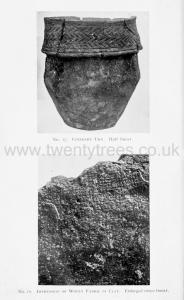
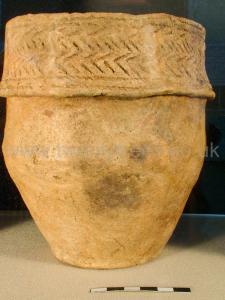 Collared urn decorated with vertical lines around rim and 2 rows of cord impressed chevrons around collar bordered by two cord impressed lines at top and bottom, found upright in cist with no cremated remains. Collection of [Map].
Collared urn decorated with vertical lines around rim and 2 rows of cord impressed chevrons around collar bordered by two cord impressed lines at top and bottom, found upright in cist with no cremated remains. Collection of [Map].
Wiltshire Museum. DZSWS:STHEAD.176. 1 Collared Urn with high shoulders and decorated with 10 cord impressed lines around overhanging collar, found with a primary cremation inside in bowl barrow Durrington G11 [Map], excavated by William Cunnington.
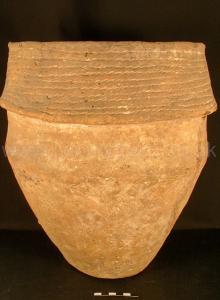
Wiltshire Museum. DZSWS:STHEAD.205. 22 fragments of a coarse linen cloth bag (or casts of cloth formed by lime carbonate) woven with double thread, found wrapping a primary cremation in an MBA collared urn in bowl barrow Durrington G11 [Map], excavated by William Cunnington.
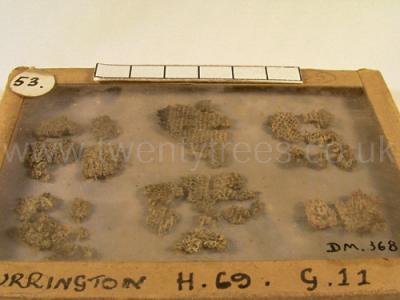
Wiltshire Museum. DZSWS:STHEAD.240. 1 miniature cup with two shoulder ridges, found with an (MBA) collared urn and secondary cremation in bowl barrow Durrington G36 [Map], excavated by William Cunnington.
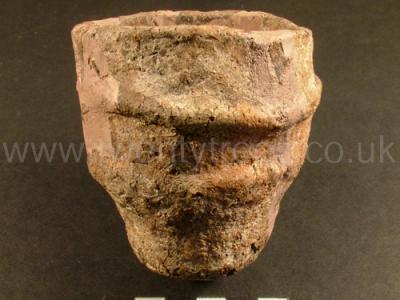
Books, Prehistory, Prehistoric Artefacts, Cup Marked Stone
Books, Prehistory, Prehistoric Artefacts, Early Ploughing
South Street Long Barrow [Map]. Historic England 1008103.
The monument includes a Neolithic Long Barrow 70m south east of the Long Stones Cove aka Devil's Quoits [Map] standing stones and c.300m north east of the Long Stones long barrow, a contemporary funerary monument. The South Street long barrow, despite having been reduced by cultivation and partly excavated, survives as a slight earthwork visible at ground level. The barrow mound is aligned ESE-WNW and is known from excavation to measure 43m in length and 17m across. However, the mound has been spread by cultivation and now measures 64m in length and 43m across. Partial excavation has shown that the mound was constructed of chalk rubble tipped into a series of forty bays, created by the laying out of hurdle fences to mark out the site immediately prior to construction. This building method provided stability to the mound and guided the workforce in deciding where to dump the material quarried from two parallel flanking ditches. These ditches are located c.7m from the base of the mound on both sides and measure c.55m long and c.7m wide. The ditches have been gradually infilled by cultivation over the years but survive as buried features beneath the present ground surface. Radio-carbon dating of some of the finds from the later excavation date the construction of the mound to around 2750BC, making the monument over 4000 years old. Finds from the excavation included flint arrowheads, animal bones and fragments of pottery. Below the barrow mound evidence of early ploughing was discovered, taking the form of lines of cross-ploughing incised into the chalk.
Books, Prehistory, Prehistoric Artefacts, Food
Charred Grain
Hembury Causewayed Enclosure [Map] is a Causewayed Enclosure located in south-east Devon. It was excavated by Dorothy Liddell between 1930 and 1935.
Liddell's excavations, 1930-35: Neolithic occupation is represented by an east to west causewayed ditch across the centre of the site; south of this was an "extensive habitation site" with numerous cooking pits (which produced a radiocarbon date of circa 3240 BC). A Neolithic ditch underlay the Iron Age defensive works by the ne entrance, and a dwelling hut (hut circle) was excavated by the west entrance. Finds included pottery (similar to Windmill Hill Pottery) both "local" and "imported", numerous flints and charred grain.
Cooking Pits
Hembury Causewayed Enclosure [Map] is a Causewayed Enclosure located in south-east Devon. It was excavated by Dorothy Liddell between 1930 and 1935.
Liddell's excavations, 1930-35: Neolithic occupation is represented by an east to west causewayed ditch across the centre of the site; south of this was an "extensive habitation site" with numerous cooking pits (which produced a radiocarbon date of circa 3240 BC). A Neolithic ditch underlay the Iron Age defensive works by the ne entrance, and a dwelling hut (hut circle) was excavated by the west entrance. Finds included pottery (similar to Windmill Hill Pottery) both "local" and "imported", numerous flints and charred grain.
Hazelnuts
Section I Tumuli 1843. August the 5th 1843 was opened a barrow called Elk Lowe [Map] (quere Ell? that being the ancient British word signifying conspicuous) situate on a considerable eminence near Newhaven. It is of the form which Dr. Stukeley assigns to Druids' barrows without any substantial grounds. The only point in which this kind of tumulus differs from the general form being in the central depression which in this case is so much extended as to spread out into a level and circular area surrounded by a more elevated ring or rampire of earth or stones. In the barrow in question this circle was constructed of very large stones inclining towards the central plain, and covered with small stones and earth, thus forming an extremely durable erection to the height of about three feet, whilst the interior area is not more than one foot above the level of the surrounding soil. In the centre of this space, upon a stratum of stiff clay, was laid a skeleton, whose head rested upon a large limestone. This clay, appearing to replace soil (which had been removed for about a foot in depth below the natural surface), was dug out and carefully examined, and from amongst it were taken a large flint arrow- or lance-head, three other instruments of the same material, and a small piece of sandstone, rubbed smooth. These articles were immediately beneath the skeleton, on whose right hand lay a deposit of burnt human bones, containing an arrow-head of flint, also calcined, and a considerable quantity of charcoal, amongst which were several hazel-nuts, still retaining their perfect form. In other parts of the area, the remains of two more skeletons and some fragments of a large urn, composed of imperfectly baked clay, profusely ornamented, were found. A few dogs' teeth were also observed. The most remarkable circumstance attending the opening of this barrow was the discovery of rats' bones in an unprecedented quantity the whole of the interior circle of the area being covered with a stratum of them not less than three inches in thickness.
Books, Prehistory, Prehistoric Artefacts, Hut Circle
Hembury Causewayed Enclosure [Map] is a Causewayed Enclosure located in south-east Devon. It was excavated by Dorothy Liddell between 1930 and 1935.
Liddell's excavations, 1930-35: Neolithic occupation is represented by an east to west causewayed ditch across the centre of the site; south of this was an "extensive habitation site" with numerous cooking pits (which produced a radiocarbon date of circa 3240 BC). A Neolithic ditch underlay the Iron Age defensive works by the ne entrance, and a dwelling hut (hut circle) was excavated by the west entrance. Finds included pottery (similar to Windmill Hill Pottery) both "local" and "imported", numerous flints and charred grain.
Books, Prehistory, Prehistoric Artefacts, Ivory
Colt Hoare 1812. No. 16 [Map]. This, and the preceding barrow, both for superiority of size, and elegance of form, may be justly considered as the two finest tumuli in this group: they stand so contiguous to each other, that their circumvallation somewhat interfere. The first mentioned, is 89 feet in base diameter, and 14 feet in elevation: the one, now the object of our inquiry, measures in its base diameter 112 feet, and about 15 feet in elevation. On making our section, we were surprised to meet with a large and heavy piece of fossil wood, of a calcareous nature, resembling a bunch of twigs. I cannot learn that there is any substance of the kind in this neighbourhood, and I am sure the earth of which the barrow is composed, could never have generated it. At the depth of nearly 15 feet, and immediately under the spot where the fossil wood was found, we came to a shallow oblong cist, in which a skeleton had been deposited within the rude trunk of an elm-tree1, with its head lying to the north-east, On the left side of the head, a beautiful urn had been deposited, but crushed to pieces by the heavy pressure of earth upon it. We were however fortunate in collecting sufficient fragments to enable Mr. Crocker to make out an exact drawing of its and outline. (Tumuli Plate XV.) This sepulchral urn is different both in shape and colour to any we have ever found in the British sepulchres. It resembles in tint the fine red Samian pottery, and appears to have been turned in a lathe; the form of the neck is neat, and the five handles are like those we see on the Roman vessels; yet with all these appearances, we have one criterion to judge by, which, I think, will prove it ta be of British manufacture, viz. that it is not more than half baked, and the fractures discover a black and sooty appearance within, not having been burned in a kiln, like the pottery of the Romans. Near the breast of the skeleton, lay the brass dagger No. 2. which had been guarded by a case of wood, part of which appeared to have been highly ornamented, as we found a bit of wood near it that had indentations which certainly had been gilt. The handle seems to have been made of box wood, and rounded somewhat like that of a large knife, Near it lay a brass pin with an ivory handle, No. g. On the same side, but near the thigh, was a fine spear-head of brass, No, 4, very perfect, and most elegantly moulded, (for I have no doubt of these articles having been cast in moulds), and another article or ivory. The rich contents of this tumulus has induced us to crown it with royal honours, and to give it the title of KING BARROW. I have often been asked, if the largest barrows were not found, on opening, to be the most productive in their contents? The question is very natural, and I have rather wished to second that supposition; but as yet I have not a basis for that hypothesis. In the present instance, indeed, there is some ground for the above remark.
Note 1. The knots and bark adhering to the tree, we were able to ascertain with certainty its distinct species some naturalists, however, suppose, that the elm was introduced from the Continent into England. at a comparatively modern period.
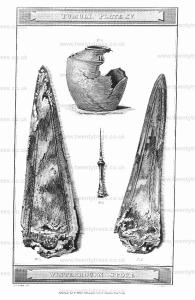
Colt Hoare 1812. No. 25 [Map] is a large and rude bowl-shaped barrow, 107 feet in diameter, and 6 in elevation. Its surface being uneven, we were led to suppose it had been opened. In making a large section into it, the workmen threw out the bones of several dogs, and some of deer, and on the floor found a human skeleton, which had been originally interred from north to south, but many of the bones had been displaced, probably owing to a recent interment of burned bones, which had been deposited near the feet of this skeleton. On the right side of its head were two small earthen cups, one of which was broken; the other preserved entire; the first, though of rude materials, and scarcely half burned, was very neatly ornamented; the other, is of a singular form and pattern: it is of a yellowish colour, and perforated in several places. Near these, cups was a curious ring or bracelet of bone or ivory, stained with red, which was unfortunately broken into several pieces. With the above articles were two oblong beads made from bone, and two whetstones; one of the silicious kind, almost as fine as a hone, and neatly formed; the other, of a fine grained white silicious stone. Near the above were brass pin, a pair of petrified fossil cockle shells, a piece of stalactite, and a hard fiat stone of the pebble kind, such as we frequently find both in the towns; as well as in the tumuli of the Britons.
Colt Hoare 1812. No. 23 [Map], Mr Cunnington attempted to explore this fine bell-shaped barrow some years ago, but was unsuccessful. On a second trial, I found that in his former operations he had left off a few inches of a large rude sepulchral urn inverted over a pile of burned bones, amongst which was an elegant pair of ivory tweezers.
Colt Hoare 1812. On the opposite hill is a beautiful group of tumuli, thickly strewed over a rich and verdant down. Their perfect appearance raised our expectations of success, and the attendance of many of my friends from Salisbury, and a beautiful day, enlivened our prospects; but we had again sad cause to exclaim Fronti nullaa fides, Trust not to outward appearances. No arrow heads were found to mark the profession of the British hunter; no gilded dagger to point out to us the chieftain of the clan; nor any necklace of amber or jet, to distinguish the British female, or to present to her fair descendants, who honoured us with their presence on this occasion: a few rude urns marked the antiquity and poverty of the Britons who fixed on this spot as their mausoleum, Unproductive, however, as were the contents of these barrows, it may not be uninteresting to the antiquary, whom either chance or curiosity leads across these fine plains, to know their history.
Note 1. On referring to Mr. CUNNINGTON'S papers, find some account of these barrows. The Druid barrows had been partially opened: in one, he found an interment, with a broken dart or lance of brass; and in another, the scattered fragments or burned bones, a Few small amber rings, beads of the same, and of jet, with the point of a brass dart. In opening the large barrow, No. 57 [Map] he found a cist, at the depth twelve feet from the surface, the remainder (as he thought) of the brass dart, and with it a curious whetstone, some ivory tweezers, and some decayed articles of bone.
Colt Hoare 1812. No. 145 [Map] is also a bowl-shaped barrow, which appeared to have undergone a prior investigation, but in examining the cist, we discovered a piece of ivory resembling the handle of a cup, and a large black pebble shaped like a kidney.
Colt Hoare 1812. No. 147 [Map]. One of these two barrows, enclosed within the same ditch, was opened by Thomas, Earl of Pembroke, in the year 1722, and is marked A in TAB. IX. of Stukeley; and described at page 44 of his Stonehenge. Although the noble Peer made an entire segment in it from centre to circumference, his researches proved unsuccessful as to the primary interment, but he found the deposit of a skeleton three feet under the surface, with its head placed in a northerly direction towards Stonehenge. Our experience having given us repeated proofs that the system of opening barrows was but imperfectly understood in former days, we determined to try our luck, and on reaching the floor soon found, owing to a stratum of chalk, a clue to the cist, which contained an interment of burned bones, and with it two articles of ivory in high preservation. The one resembles in shape a small lance-head, the other is like the handle of a cup. Each is engraved in Tumuli Plate XXIV. The latter is the third article of the sort we have discovered, yet can we form no idea to what use it was appropriated. In the smaller barrow Dr. Stukeley had cleared a part of the floor, but not finding any interment, he left two half-pence covered with stones; one of the reign of King WILLIAM the Third, the other of King GEORGE the First, 1718. This last is in high preservation, though the period of 86 years has elapsed since it was deposited. On meeting with these tokens, our labourers left off work, thinking that the learned Doctor bad been beforehand with us, but from the circumstance of not meeting with any fragments of bones, Mr. Cunnington desired them to continue their researches; when, on exploring the floor of the barrow, they soon perceived the well known line of chalk, which led them to a cist at the east end of the barrow, and to an interment of burned bones, with which were deposited four amber beads, two of jet with convoluted stripes, and a little broken cup.
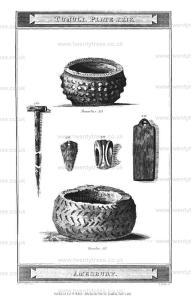
Colt Hoare 1812. No. 15 [Map]. On clearing the earth from our section in this beautiful bell-shaped tumulus, and after four days labour, we came to an interment differing from any we had yet met with; for instead of finding the burned bones of the deceased, enclosed within the native chalk, or in a sepulchral urn, we perceived they had been deposited in a box or coffin of wood, about three feet and a half long, by two feet wide, and placed upon the native turf; the whole was then covered with a coat of blueish clay, and the mound constructed. On removing the clay, and the mouldering fragments of the wood1, we first discovered small pieces of ivory, with rivets of brass through each, which I think appertained and afterwards a beautiful spear head of brass, the most co the tips of a bow; perfect and the largest we have as yet found; close to this was another lance head, which was unfortunately broken; it lay above a foot from the bones, near which was a long pin of ivory, not perforated, but neatly polished and pointed at the thinnest end; and another instrument of the same material, resembling the tweezers engraved in Tumuli Plate III. The human bones had been piled up in a heap, and intermixed with them were some rivets, and small strips of brass, which probably belonged originally to the box. In making the section of this barrow, the workmen found the remains of five or more skeletons, at a short depth beneath the surface of the sepulchral mound.
Note 1. This box was placed in a direction from north to south. The wood of which it was composed appeared be elm, yet we found also some pieces of oak.
Note 2. This fine spear-head, together with the two pieces of ivory, are engraved of their natural size in Tumili Plate XIV.
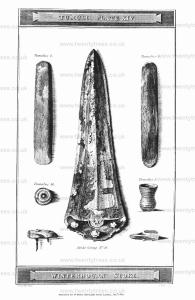
Books, Prehistory, Prehistoric Artefacts, Ivory Pin
Section I Tumuli 1843. The 30th of June 1843 was occupied in examining the middle part of a large barrow on Brassington Moor, usually called Galley Lowe [Map], but formerly written Callidge Lowe, which is probably more correct. About two feet from the surface were found a few human bones mixed with rats' bones and horses' teeth; amongst these bones (which had been disturbed by a labourer digging in search of treasure) the following highly interesting and valuable articles were discovered: several pieces of iron, some in the form of rivets, others quite shapeless, having been broken on the occasion above referred to, two arrow-heads of the same metal, a piece of coarse sandstone, which was rubbed into the form of a whetstone; an ivory pin or bodkin, of very neat execution; the fragments of a large urn of well-baked earthenware, which was glazed in the interior for about an inch above the bottom; two beads, one of green glass, the other of white enamel, with a coil of blue running through it, and fourteen beautiful pendant ornaments of pure, gold, eleven of which are encircled by settings of large and brilliantly coloured garnets, two are of gold without setting, and the remaining one is of gold wire twisted in a spiral manner, from the centre towards each extremity (a gold loop of identical pattern is affixed to a barbaric copy of a gold coin of Honorius in the writer's possession); they have evidently been intended to form one ornament only, most probably a necklace, for which use their form peculiarly adapts them. It will here not be out of place to borrow some quotations relative to a remarkable superstition connected with glass beads similar to those discovered in Galley Lowe, particularly the one having "two circular lines of opaque sky-blue and white," which seem to represent a serpent entwined round a centre, which is perforated. "This was certainly one of the Glain Neidyr of the Britons, derived from glain, which is pure and holy, and neidyr, a snake. Under the word glain, Mr. Owen, in his Welsh Dictionary, has given the following article: "The Nair Glain, transparent stones, or adder stones, were worn by the different orders of the Bards, each exhibiting its appropriate colour. There is no certainty that they were worn from superstition originally; perhaps that was the circumstance which gave rise to it. Whatever might have been the cause, the notion of their rare virtues was universal in all places where the Bardic religion was taught."
These beads are thus noticed by Bishop Gibson, in his improved edition of Camden's Britannia: "In most parts of Wales, and throughout all Scotland, and in Cornwall, we find it a common opinion of the vulgar, that about Midsummer-eve (though in the time they do not all agree) it is usual for snakes to meet in companies, and that by joining heads together and hissing, a kind of bubble is formed, like a ring, about the head of one of them, which the rest, by continual hissing, blow on, until it comes off at the tail, when it immediately hardens, and resembles a glass ring, which whoever finds shall prosper in all his undertakings: the rings they supposed to be thus generated are called gleinen nadroeth, namely, gemma anguinum. They are small glass annulets, commonly about half as wide as our finger-rings, but much thicker, of a green colour usually, though some of them are blue, and others curiously waved with blue, red, and white.'' There seems to be some connexion between the glain neidyr of the Britons and the ovum anguinnm, mentioned by Pliny as being held in veneration by the Druids of Gaul and to the formation of which he gives nearly the same origin. They were probably worn as a mark of distinction, and suspended round the neck as the perforations are not large enough to admit the finger. A large portion of this barrow still remaining untouched on the south-east side, which was but little elevated above the natural soil, yet extending farther from the centre, it offered a larger area, in which interments were more likely to be found than any other part of the tumulus, it was decided on resuming the search on the 3d of July, 1843, by digging from the outside until the former excavation in the centre was reached. In carrying out this design the following interments were discovered, all of which seem to pertain to a much more remote era than the interment whose discovery has been before recorded. First, the skeleton of a child, in a state of great decay; a little farther on a lengthy skeleton, the femur of which measures nineteen and a half inches, with a rudely ornamented urn of coarse clay deposited near the head; a small article of ivory, perforated with six holes, as though for the purpose of being sewn into some article of dress or ornament (a larger one of the same kind was found in a barrow at Gristhorpe, near Scarborough, in 1832); a small arrow-head of gray flint, a piece of iron-stone, and a piece of stag's horn, artificially pointed at the thicker end, were found in the immediate neighbourhood of the urn. Between this skeleton and the centre of the barrow four more skeletons were exhumed, two of which were of young persons; there was no mode of arrangement perceptible in the positions of the bodies, excepting that the heads seemed to lie nearest to the urn before mentioned. Amongst the bones of these four skeletons a small rude incense cup was found, which is of rather unusual form, being perforated with two holes on each side, opposite each other.
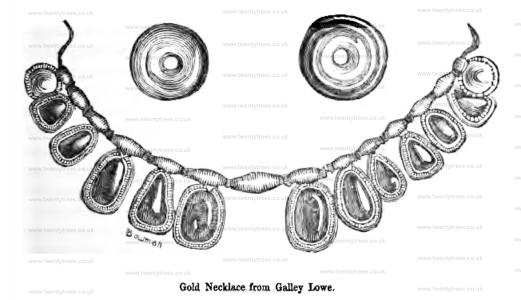
Thomas Bateman 1846. On the 12th of August 1846, was opened a low flat barrow at Windle (Wind Lowe) Nook [Map], near Hargate Wall, Derbyshire, about twenty yards in diameter, two feet high, and encircled by a ring of large flat limestones, placed in a sloping manner on one side, about three yards from the margin of the tumulus, apparently for the purpose of preserving its symmetry. The top of this barrow is surmounted by a large square sandstone, which has originally formed the base of one of the wayside crosses, of which numerous examples remain in the north of Derbyshire. About the centre of the barrow was a cist, measuring near six feet by four, in horizontal area, and three feet in depth, of unusual construction, the sides being built of large stones set on end, some of which appeared above the turf; an examination of the contents of this cist led to the conclusion that it had been applied to sepulchral purposes at various distinct periods, and that the last interment had been partially disturbed at a comparatively recent period; the contents were as follows: small pieces of urn, calcined bones and flints, skeletons of two persons of full stature, and of two infants, one of them very young, and various animal bones, amongst which, those of the rat, weasel, and horse were most conspicuous. All these articles were so much out of their ordinary arrangement, as to leave no doubt of their disinterment at the time of the burial of another skeleton, which lay in a contracted position a few inches above the floor of the vault; this skeleton, which, from the ornaments discovered with it, and the slender proportions of the bones, must be attributed to a female, had not entirely escaped spoliation at a recent period; the following circumstances seem to put this question beyond doubt, namely, the discovery of sundry pieces of tobacco-pipe, and nails from rustics' shoes, and from the fact of finding part of a very large ivory pin, and a fragment of an armilla or bracelet of Kimmeridge coal, both of which would undoubtedly have been perfect at the time they were deposited. Whoever these former excavators were, they were not very close observers as they had overlooked a necklace of beads of the aforesaid Kimmeridge coal, terminated by two perforated conical studs of the same, and enriched by six pieces of ivory, ornamented with the everlasting chevron or zig-zag pattern so universally prevalent on Celtic remains. The beads, exclusive of the studs and ornaments, are seventy-six in number, and are identical with two that are figured in plate 3, vol. i of Sir. Richard Hoare's excellent work. The ivory ornaments are quite novel, no other example having been published.
Note. The necklace discovered at Wind Low on display at Weston Park Museum, Sheffield.
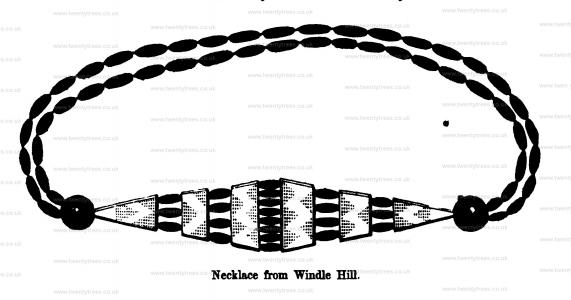

Books, Prehistory, Prehistoric Artefacts, Lance-Head
Colt Hoare 1812. No. 144 [Map], a wide bowl-shaped barrow, composed entirely of vegetable earth, contained the remains of a skeleton, much decayed, and deposited within an oblong cist, with its head towards the north, and accompanied by a small lance-head of brass.
Colt Hoare 1812. No. 147 [Map]. One of these two barrows, enclosed within the same ditch, was opened by Thomas, Earl of Pembroke, in the year 1722, and is marked A in TAB. IX. of Stukeley; and described at page 44 of his Stonehenge. Although the noble Peer made an entire segment in it from centre to circumference, his researches proved unsuccessful as to the primary interment, but he found the deposit of a skeleton three feet under the surface, with its head placed in a northerly direction towards Stonehenge. Our experience having given us repeated proofs that the system of opening barrows was but imperfectly understood in former days, we determined to try our luck, and on reaching the floor soon found, owing to a stratum of chalk, a clue to the cist, which contained an interment of burned bones, and with it two articles of ivory in high preservation. The one resembles in shape a small lance-head, the other is like the handle of a cup. Each is engraved in Tumuli Plate XXIV. The latter is the third article of the sort we have discovered, yet can we form no idea to what use it was appropriated. In the smaller barrow Dr. Stukeley had cleared a part of the floor, but not finding any interment, he left two half-pence covered with stones; one of the reign of King WILLIAM the Third, the other of King GEORGE the First, 1718. This last is in high preservation, though the period of 86 years has elapsed since it was deposited. On meeting with these tokens, our labourers left off work, thinking that the learned Doctor bad been beforehand with us, but from the circumstance of not meeting with any fragments of bones, Mr. Cunnington desired them to continue their researches; when, on exploring the floor of the barrow, they soon perceived the well known line of chalk, which led them to a cist at the east end of the barrow, and to an interment of burned bones, with which were deposited four amber beads, two of jet with convoluted stripes, and a little broken cup.

Colt Hoare 1812. The two first [No. 128 [Map] and No. 129 [Map]] had experienced a prior opening, but the cist of the latter, containing an interment of burned bones with a lance-head of brass, had escaped unnoticed. The third also had been partially opened; but some of the interments remained perfect and were attended with some novel and singular circumstances. At the depth of about a foot and a half from the surface, we discovered a skeleton with a drinking cup, and lower down a deposit of burned bones. On the east side of the barrow lay the skeletons of two infants, one with its head towards the east, the other towards the west, each placed over the head of a cow, which from fragments of the horns appeared to have been of a small size. We afterwards found a cist nearly four feet deep in the chalk, which contained, as we conceived, the primary interment, viz, the skeleton of a man; but these relicks had been disturbed, and some brazen articles, with which the bones were tinged had been removed.
Books, Prehistory, Metal Prehistoric Artefacts
Books, Prehistory, Prehistoric Artefacts, Miniature Cup
Wiltshire Museum. DZSWS:STHEAD.240. 1 miniature cup with two shoulder ridges, found with an (MBA) collared urn and secondary cremation in bowl barrow Durrington G36 [Map], excavated by William Cunnington.

Wiltshire Museum. DZSWS:STHEAD.82. 1 miniature cup (incense cup?) without decoration found with a primary cremation in bowl barrow Winterbourne Stoke G58 [Map], excavated by William Cunnington.
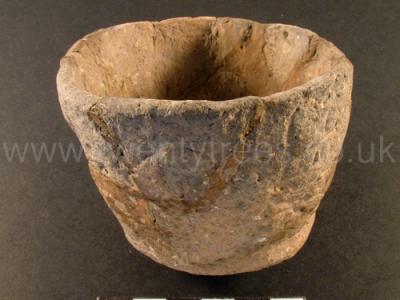
Wiltshire Museum. DZSWS:STHEAD.99 1 miniature cup (or incense cup) with three lines of cord impressions around a thick collared rim and one below and diagonal cord impressions on the thick rim top found with a primary cremation in central tump of three tumps in disc barrow Winterbourne Stoke G14 [Map] (?), excavated by William Cunnington.
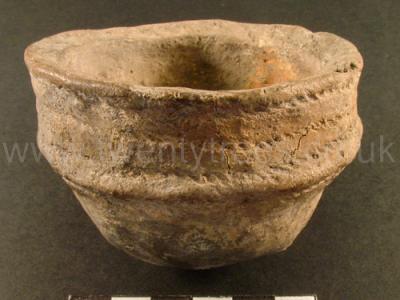
Books, Prehistory, Prehistoric Artefacts, Quartz Pebbles
Section I Tumuli 1821. In February 1821, the Kenslow farm [Map], near Middleton-by-Yolgrave [Map], being planted and otherwise improved, a barrow [Map] was discovered upon the most elevated part of the land. In the nomenclature of Sir R. C. Hoare (age 62), it was a bowl barrow, composed of earth and stones, of about thirty feet in diameter, and its perpendicular height not more than three feet, with the usual shallow cavity on the top, five feet in diameter. The examination was commenced by a transverse section from the south side towards the middle of the tumulus. On approaching about six feet towards the centre a few human bones were discovered, promiscuously blended with those of a small animal, which Dr. Buckland has decided to be of the water rat (Reliquia Diluviana, plate ii, figs. 1, 2, 3, and 12), intermixed with a fine dry sand or mouldy slightly indicating calcination among which was a piece of ivory or bone the one side of which is convex the other flat with two perforations equidistant from the points which probably allowed of its being worn as a pensile ornament from the neck. In the centre of the barrow the rats' bones appeared in large quantities and in digging a little below the level of the natural ground the discovery of the primary deposit was made consisting of two skeletons one entire and the other nearly so laid at full length, about eighteen inches below the surface, in a cist or excavation of the soil, guarded nearly round, but particularly on the south and east sides, by large stones. The bodies had been deposited side by side, with their heads to the north-west; each head was placed in the hollow of a mass of magnesian lime-stone (of which the hill is composed), and reclining on the right side. Neither of them could be conveniently measured, but a thigh-bone was exactly eighteen inches in length, which, in a well-proportioned man, gives a height of about five feet ten inches. It is remarkable that not a tooth was wanting, or in the least decayed, in the jaws of either; and though, in one more particularly, the molars were much worn, as if by the mastication of hard substances, the enamel was still retained. The bones generally were but little decayed. One of the skulls appears to have been that of a man in the decline of life, and exhibits phrenological developments indicative of some of the worst passions incident to human nature. The other skull was crushed on removing the stone on which it lay. Near the bodies, and especially about the heads, a large quantity of the rats' bones and fine mould were strewed, with many round pebbles of various sizes, chiefly of quartz, which, in the opinion of Sir R. C. Hoare (age 62), were used in the sling. On the breast of the entire skeleton lay a circular fibula, or brooch, of copper or bronze. There was also a large quartz pebble and a fragment of pottery of red clay. Between the bodies was placed an axe- or hammer-head of basalt, in a decomposed state, and broken in the middle. In the same situation was found a porphyry slate pebble, highly polished, of very singular shape, four and a half inches in length, the same in medium circumference, the sides triangular and tapering towards the ends, which are rubbed flat. In vol, xii, p. 327, of the "Archæologia" a similar stone is described and engraved which was found in a barrow near Ashford-in-the-Water [Map] by Major Rooke. Behind the head lay a tusk apparently that of a dog and a molar tooth of the lower jaw of a horse. On these little if any decay seemed to have taken place.
Section I Tumuli 1844. June the 10th, 1844, was opened a barrow [Map] upon Elton Moor, for which there is no distinctive name; it was on this occasion divided into four quarters by our sections, which left very little of the mound unexplored. In the usual central situation was found a previously-disturbed interment, accompanied by a large arrow- or spear-head of flint, a piece of a small urn neatly ornamented, and some animal teeth. On the southern side of the tumulus another interment was discovered, about eighteen inches below the natural surface of the land upon which the barrow was constructed; this skeleton was certainly that of an aged person, the teeth being much worn down; near the head was a piece of spherical iron pyrites, now for the first time noticed as being occasionally found with other relics in the British tumuli. Subsequent discoveries have proved that it was prized by the Britons, and not unfrequently deposited in the grave along with the weapons and ornaments which formed the most valued part of their store; even to the present day, the same mineral is used as a personal decoration by some tribes of the South American Indians. In the rear of the skeleton was a neatly-ornamented drinking-cup, which had been crushed by the weight of the soil, with which it had in a great degree become incorporated; within this cup the following odd assemblage of articles were placed: three quartz pebbles, one of which is red, the other two of a light colour; a flat piece of polished iron ore, a small celt of flint, with the peculiarity of having a round polished edge, instead of a cutting one as is usual; a beautifully-chipped cutting tool, twenty-one circular instruments almost all neatly chipped, and seventeen pieces, or rude instruments, all of flint, which had been turned to a delicate white or gray by calcination. Scattered about in the immediate neighbourhood of this interment were a good many pieces of burnt bones, not sufficient in quantity to compose a complete deposit, and a few rats' bones as usual.
Section I Tumuli 1844. On the 30th of July, 1844, was re-examined a barrow [Map] upon the Oldham Farm, Middleton, which was unsuccessfully opened by Mr. William Bateman, on the 18th of May, 1825, nor was this second investigation much more interesting, as the barrow proved in most respects the same as the one on Ringham Lowe [Map], which is within half a mile of the one in question. There were the remains of a large fire visible in the centre of this mound, upon the level of the undisturbed soil, where were also some pieces of sandstone and some quartz pebbles, neither of which are to be found in the neighbourhood. The only articles of human origin were several pieces of kneaded clay, partially hardened by the fire, and a broken piece of coarse pottery of very hard texture.
Books, Prehistory, Prehistoric Artefacts, Skeletons
Section I Tumuli 1788. On the 15th of March, 1788, a farmer, who occupied the land on Middleton Moor, known as the Garratt Piece, having occasion to burn some lime upon that ground, dug for the purpose into a tumulus [Map] [Garratts Piece Barrow [Map]], or lowe, there situate.
He began his work on the outer edge of the barrow, clearing it away as he proceeded, to the level of the natural surface. On reaching the centre, he found, lying immediately under the usual depression of the summit of the barrow, and placed upon the level of the ground, a skeleton, whose extremities were towards the east and west; near the point of the shoulder was a very extraordinary ornament of copper neatly enamelled with various colours, red being the most predominant; it is circular, and has a hook in the form of a serpent's head, probably for suspension. In addition to this, part of another ornament of similar workmanship; part of the iron umbo of a shield and a shallow basin of thin brass, much broken and crushed, were found abont the same place. (For a similar basin see Archæologia, vol. xviii, page 80.) The design visible upon the circular and enamelled ornament is precisely similar to an illuminated capital Q in the Saxon manuscript entitled, 'Textus Sancti Cuthberti,' a production of the seventh century, formerly preserved in the cathedral of Durham, but now in the Cottonian library, (Nero, D. 4.) There is a good engraving of it in Astle's 'Origin of Writing,' plate 14, a. This interesting barrow was reopened by Mr. William Bateman (age 1), on the 19th of June, 1826, but was found to have been entirely rifled on the occasion above described.
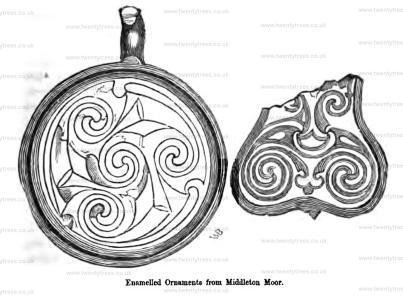
Human Bones
West Kennet Long Barrow [Map] is a Severn Cotswolds Tomb type tomb, probably constructed in the 3700s BC. Human bones of men, women and children were placed in the chambers between 3670 and 3635 BC. The site appears to be subsequently re-used between 3620 and 3240 BC. In the late Neolithic it was blocked up with the addition of large sarsen boulders. It is 100m in length, 20m wide, constructed from earth with ditches on both sides, oriented east-west. At the east end are multiple chambers formed off a passage that extends 12m into the barrow. The ceiling is between 1.7 and 2.2m high - sufficient to allow an adult to stand upright.
Finds included Grooved Ware, Beaker Ware, Ebbsfleet Ware, Mortlake Ware and Fengate Ware coming from more than two hundred and fifty vessels.
Human Jawbone
Knap Hill [Map]. Historic England 1005704.
Summary: The site of Knap Hill, a Causewayed Enclosure. It encompasses an area of circa 2.4 hectares and consists of a single circuit of sub-triangular plan, conforming to the contours of the hill and possibly incomplete on the steepest, southern side. Exceptionally compared to other enclosures, the causeways seem to correspond precisely to gaps in the bank. It is unclear if the earthworks ever formed a complete enclosure. Excavations by the Cunningtons in 1908-9 first demonstrated the causewayed nature of the earthworks, as well as recovering pottery which they felt to be Neolithic in date. Further excavations in 1961 confirmed the Cunningtons' observations. Romano British pottery and an extended inhumation probably relates to the adjacent, later earthwork enclosure. The site and its archaeological history were re-investigated as part of the RCHME project focusing on enclosure and industry in the Neolithic period in 1995. Knap Hill was also subsequently included in a research programme into the dating of the early Causewayed Enclosures of southern Britain and of Ireland. The results suggested that Knap Hill was probably constructed in the 35th century cal BC, (that is to say between 3500-4001cal BC) probably more than a century later than Windmill Hill and the West Kennet long barrow [Map]. It is unclear, however, for how long activity continued. On the basis that the ditch was left to infill naturally, that there is no sign of recutting, and because there is a scarcity of sherds and bones, a short duration, probably of well under a century and perhaps only a generation or two, is possible.
More information: (SU 12106368) Neolithic Camp (NR) Knap Hill (NAT).
A causewayed camp on Knap Hill (see plan), excavated by BH and ME Cunnington in 1908-9 and G Connah in 1961. The excavations revealed Windmill Hill sherds in the silting of the ditches, Beaker sherds on the surface of the ditches and Romano-British sherds, probably associated with the plateau enclosure (see SU 16 SW 13). Other finds nearly all from within a few feet of the bottom of the ditch include fragments of red deer antlers, a human jawbone, flint flakes and a few sarsen chips. The finds are now in [Map]. Connah concludes from his excavations that the causewayed ditches undoubtedly belong to the Windmill Hill culture and that the scarcity of the pottery and occupation material may suggest that the camp was of a defensive character and abandoned at an early stage - perhaps before completion.
Radiocarbon dating of antler fragments from the primary rubble of the ditch - 4710+- 115 BP or 2760BC. Charcoal from the upper silting of the ditch - 3790+- 130BP or 1840BC.
SU 12106365 Knap Hill causewayed camp occupies a hill top position overlooking the Pewsey Vale to the S. The causewayed bank can be traced only on the N and W sides, but accepting the natural gradient of the hill for the eastern and southern extent, then the area enclosed would have been approximately 1.7 hectares. There is a bowl barrow (see SU 16 SW 23) and some flint digging disturbance within the camp, and in the E the perimeter of the IA/RB "plateau" enclosure obscures the terminal on the causewayed bank. Resurveyed in conjunction with RCHM manuscript plan at 1:2500.
The Neolithic causwayed enclosure and associated features described by the previous authorities have been mapped at 1:10,000 scale from aerial photographs and the 1:1000 plan produced as part of the industry and Enclosure in the Neolithic Project (Event UID 923509).
Surveyed by the RCHME as part of the above project.
Knap Hill encloses an area of 2.4 hectares and consists of a single circuit of sub-triangular plan, conforming to the contours of the hill and possibly incomplete on the steepest, southern side. Exceptionally to other enclosures, the causeways seem to correspond precisely to gaps in the bank.
Two radiocarbon dates were obtained by Connah following his 1961 excavations (Table 3.3: BM-205, -208; Connah 1969). They bracket the infilling of the ditch, the sample for BM-205 coming from near the base and that for BM-208 from the topmost fill. BM-205 was measured on an antler implement which had arguably been used to dig the ditch and would have been contemporary with that event. BM-208 was measured on an unidentified bulk charcoal sample which may have included material of diverse ages, and can hence provide only a terminus post quem for its context.
Knap Hill was included in a research programme into the dating of the early Causewayed Enclosures of southern Britain and of Ireland, using chronological estimates produced by Bayesian statistical analysis of radiocarbon dates. In addition to attempting to establish a construction date and duration for the monument, the proximity of the site to Windmill Hill and to a concentration of long barrows posed the question of its chronological relation to them. Six further radiocarbon measurements were therefore obtained. A model which incorporates this interpretation of the archaeological sequence with the radiocarbon dates was constructed. The model suggested that Knap Hill was probably constructed in the 35th century cal BC, probably rather more than a century later than both Windmill Hill Causewayed Enclosure [Map] and the West Kennet long barrow [Map]. It is unclear, however, for how long activity continued at this enclosure. On the basis that the ditch was left to infill naturally and there is no sign of recutting, and because there is a scarcity of sherds and bones, a short duration, probably of well under a century and perhaps only a generation or two, is plausible.
Books, Prehistory, Prehistoric Artefacts, Tools
Copper Knives
The Amesbury Archer [Map] is the remains of a man aged around forty at the time of his death from the Alps who was buried in Amesbury around 2300BC and discovered in May 2002 during the development of new housing. He is named 'The Archer' as a consequence of the large number of arrowheads found with him. His grave contained the largest number of artefacts of any grave of a similar period including the earliest known gold objects in England, five beaker funerary pots, three tiny copper knives, sixteen barbed flint arrowheads, a kit of flint-knapping, metalworking tools including cushion stones and some boar tusks. On his forearm was a black stone wrist guard. A similar red wrist guard was by his knees with a shale belt ring and a pair of earrings, the oldest gold objects found in England. An eroded hole in his jaw showed that he had suffered from an abscess, and his missing left kneecap suggests that he had an injury that left him with a painful lingering bone infection. His remains are on display in the Salisbury and South Wiltshire Museum [Map].
The Amesbury Archer's Companion is the remains of a man raised locally aged between twenty-five and thirty at the time of his death buried around 2300BC near to the Amesbury Archer. He appears to be related to the Amesbury Archer as they shared a rare hereditary anomaly, calcaneonavicular coalition, fusing of the calcaneus and of the navicular tarsal (foot bones). Inside his jaw were found a pair of gold earrings or hair ornaments in the same style as the Amesbury Archer's.
Photos sourced from Salisbury and South Wiltshire Museum [Map] and Wessex Archaeology.
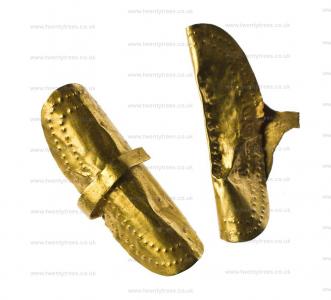
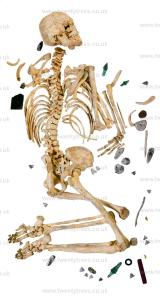
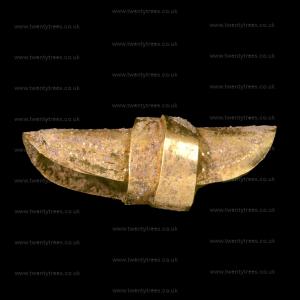
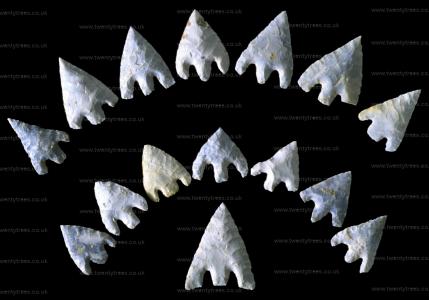
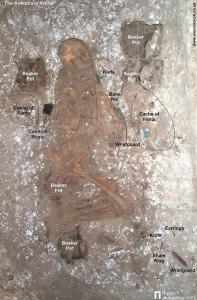
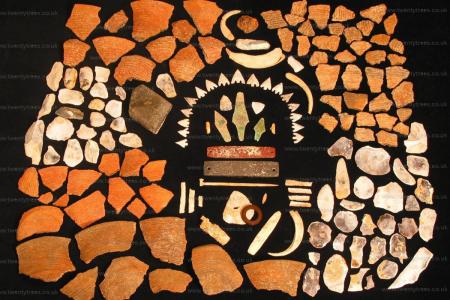
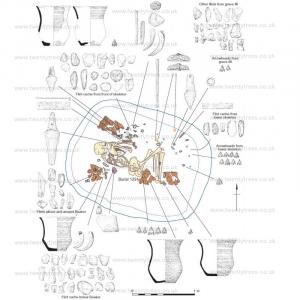
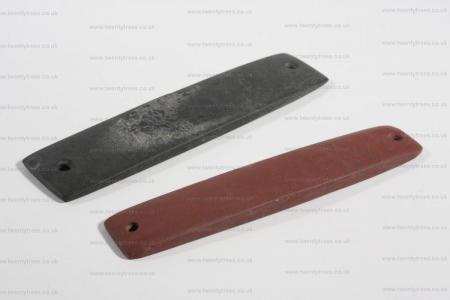
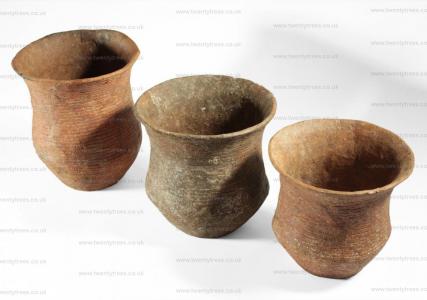
Books, Prehistory, Prehistoric Artefacts, Tweezers
Colt Hoare 1812. On the opposite hill is a beautiful group of tumuli, thickly strewed over a rich and verdant down. Their perfect appearance raised our expectations of success, and the attendance of many of my friends from Salisbury, and a beautiful day, enlivened our prospects; but we had again sad cause to exclaim Fronti nullaa fides, Trust not to outward appearances. No arrow heads were found to mark the profession of the British hunter; no gilded dagger to point out to us the chieftain of the clan; nor any necklace of amber or jet, to distinguish the British female, or to present to her fair descendants, who honoured us with their presence on this occasion: a few rude urns marked the antiquity and poverty of the Britons who fixed on this spot as their mausoleum, Unproductive, however, as were the contents of these barrows, it may not be uninteresting to the antiquary, whom either chance or curiosity leads across these fine plains, to know their history.
Note 1. On referring to Mr. CUNNINGTON'S papers, find some account of these barrows. The Druid barrows had been partially opened: in one, he found an interment, with a broken dart or lance of brass; and in another, the scattered fragments or burned bones, a Few small amber rings, beads of the same, and of jet, with the point of a brass dart. In opening the large barrow, No. 57 [Map] he found a cist, at the depth twelve feet from the surface, the remainder (as he thought) of the brass dart, and with it a curious whetstone, some ivory tweezers, and some decayed articles of bone.
Colt Hoare 1812. No. 15 [Map]. On clearing the earth from our section in this beautiful bell-shaped tumulus, and after four days labour, we came to an interment differing from any we had yet met with; for instead of finding the burned bones of the deceased, enclosed within the native chalk, or in a sepulchral urn, we perceived they had been deposited in a box or coffin of wood, about three feet and a half long, by two feet wide, and placed upon the native turf; the whole was then covered with a coat of blueish clay, and the mound constructed. On removing the clay, and the mouldering fragments of the wood1, we first discovered small pieces of ivory, with rivets of brass through each, which I think appertained and afterwards a beautiful spear head of brass, the most co the tips of a bow; perfect and the largest we have as yet found; close to this was another lance head, which was unfortunately broken; it lay above a foot from the bones, near which was a long pin of ivory, not perforated, but neatly polished and pointed at the thinnest end; and another instrument of the same material, resembling the tweezers engraved in Tumuli Plate III. The human bones had been piled up in a heap, and intermixed with them were some rivets, and small strips of brass, which probably belonged originally to the box. In making the section of this barrow, the workmen found the remains of five or more skeletons, at a short depth beneath the surface of the sepulchral mound.
Note 1. This box was placed in a direction from north to south. The wood of which it was composed appeared be elm, yet we found also some pieces of oak.
Note 2. This fine spear-head, together with the two pieces of ivory, are engraved of their natural size in Tumili Plate XIV.

Colt Hoare 1812. No. 23 [Map], Mr Cunnington attempted to explore this fine bell-shaped barrow some years ago, but was unsuccessful. On a second trial, I found that in his former operations he had left off a few inches of a large rude sepulchral urn inverted over a pile of burned bones, amongst which was an elegant pair of ivory tweezers.
Bailey Hill. On the 3rd of August we opened a barrow on Bailey Hill [Map], between the Dove and Bostom, on the Derbyshire side of the stream. It was raised upon a very irregular protuberant rock, which in the middle was cut through the loose upper beds into a kind of grave, the bottom of which, conforming to the dip of strata, was three feet deep at one end, whilst it diminished to nothing at the other. In this were three interments, the most primitive of which had been disturbed by the later deposits, its bones being found at intervals from the surface downwards. The bones were those of a full-grown person, and much decayed. A second skeleton was found undisturbed at the bottom, on which it lay on its right side, with the body slightly curved, the knees contracted, and the head to the west. Before the face was a small plain vase, lying on its side, and at the back of the skull was a very large tusk from the wild boar. The femur measures about 16 J inches. About a foot below the surface was a deposit of calcined bones, containing a very neatly made pair of tweezers of bone, unbumt, and perforated for suspension. The grave was filled up with stone, and the artificial part of the roound consisted of similar materials, amongst which rats' bones so much abounded as to fill up most of the interstices from the surface to the bottom of the grave. A few pieces of two vessels were picked up during the day. The following remarks upon the barrow, made by Mr. Carrington immediately after the opening, are valuable. He says — "I consider this to be the most primitive barrow I ever opened, as the small instrument of bone may have been deposited with the burnt bones at a much more recent period than that in which the mound was originally constructed. The coarse urn, without any decoration — the absence of every other article, with the exception of the boar's tusk — serve to strengthen this supposition. The contents of the cist were examined with the greatest care, yet nothing more was discovered, except one small round piece of ironstone — not a sandstone, or pebble, or charcoal (which are all commonly found in Celtic barrows) — not even one bit of flint was to be seen. This is the first barrow I have opened in which the latter material has not been present."
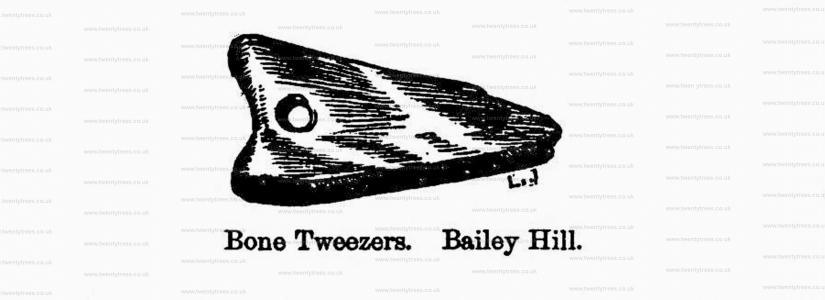
Diary of a Dean by Merewether. 24. Bronze tweezers.
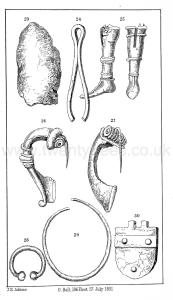
Wiltshire Museum. DZSWS:STHEAD.21a. 1 bone tweezers (broken) perforated at head for suspension, found with a primary cremation placed in a wooden box covered in clay in bell barrow Winterbourne Stoke G4 [Map], excavated by William Cunnington.
